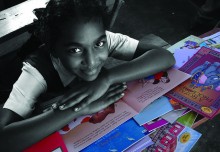
You may have heard the quandary: How do you eat an elephant?
And it’s answer: One bite at a time.
But how do you read: “an elephant?”
Same answer: One bite at a time.
Learning to read is something that happens over time. Little by little. Bit by bit.
As the saying goes: “You can’t cram farming.”
(As in, it takes time: sow the seed, sun, rain, and time. Patience. Tending. And more time. Before the harvest.)
The same is true for any complex skill. And reading is a complex skill. But it can be broken down into bite size mouthfuls and ingested over time.
If we want to get technical, how do you read “an elephant?”
Perhaps it’s one phoneme “a – n e – l – e – ph – a – n – t” or even one grapheme at a time. (I’ll write about phonemes and graphemes another time.)
Eventually, though, even if we learn to read “an elephant” one bit(e) at a time, once we know words, we typically read them in one gulp: “an” “elephant” recognizing each whole word in one go. We don’t sound out elephant every time we come across it.
There are lots of theories about learning to read.
Things come in and out of fashion: the age to start teaching kids, sight words, phonics, reading systems, etc.
The most important thing that a parent can do is read to their child.
Out loud.
A little bit.
Every day.
Talk about the picture on the cover.
Talk about what might happen.
Read a little.
Talk about what’s happening.
Talk about what’s going on in the pictures.
Guess what will happen next.
Read some more.
Talk about what happened.
Definitely, having librarians and teachers that get the “just right” book in the hands of your child helps.
Working on phonics or sight words helps.
Practicing segmenting and blending helps.
Reading books with repetition or rhyming where the child “reads” along (as in repeats from memory) or guesses the last word helps.
Books like: Silly Sally Went To Town, Walking Backwards Upside Down.
Repetitive. Rhyming. And fun!
Seriously, walking backwards upside down?!
Some would be proponents of “whole word” recognition.
There are lots of strategies and techniques, some of which I’ll write about as we go along.
What cannot be replaced is … YOU!
You are the key to your child’s reading.
Do they see you reading?
Do you read to and with them?
Don’t worry that you’ve never heard the words phoneme or grapheme or segmenting before, neither had I, and I (along with their mom, their grandparents, cousins, and their teachers and librarians, and maybe even an iPad and some apps at times) have helped my kids learn to read, and to enjoy reading.
You may not feel like you can eat the elephant.
Your child may not feel like she can eat the elephant.
It’s not that appetizing.
Don’t try to eat the elephant.
She can’t eat it all in a day.
And she won’t learn to read overnight.
Just eat the first bite.
Together.
Read a book for 5 or 10 minutes with your child tonight.
If you’re interested in some more ideas about helping a child take on a big or overwhelming challenge, read “Hopping Stones: Leverage “The Power of Small Wins” in Teaching Kids to Read.“




